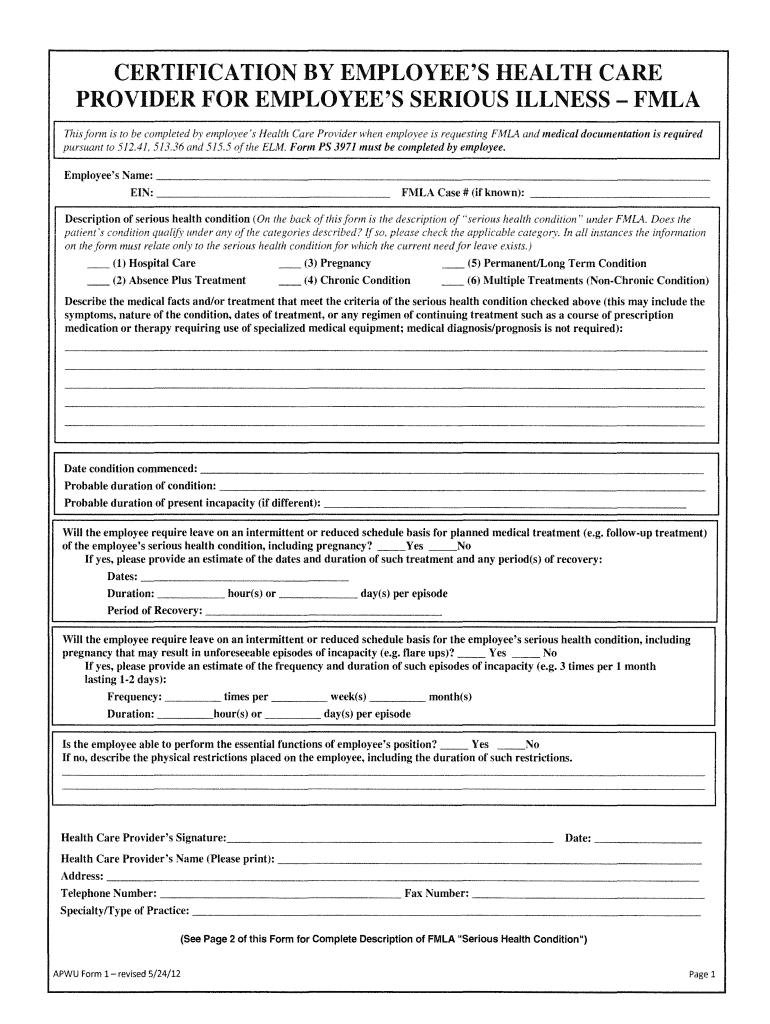FMLA Paperwork: A Simple Guide to Getting It Signed

Understanding FMLA

The Family and Medical Leave Act (FMLA) is a critical piece of legislation that allows eligible employees to take up to 12 weeks of unpaid, job-protected leave per year for specific family and medical reasons. Whether you're dealing with the birth or adoption of a child, serious health conditions, or caring for a family member, understanding the FMLA paperwork process is crucial to ensure you receive the benefits you're entitled to. Here's how to navigate the FMLA paperwork smoothly:
FMLA Eligibility

Before diving into the paperwork, ensure you meet the following criteria:
- Employment: You must work for a covered employer, which typically includes any employer with 50 or more employees.
- Work Hours: You need to have worked for at least 1,250 hours over the 12 months preceding the leave.
- Work Location: Your workplace must have 50 employees within 75 miles of your worksite.
Verify your eligibility with your HR department or through your company's employee handbook.
Steps to Get FMLA Paperwork

Navigating FMLA paperwork can seem daunting, but here's a structured approach to simplify the process:
1. Notify Your Employer
Once you determine the need for FMLA, notify your employer or HR department as soon as possible. The process should be:
- Verbally: Let them know your intention to take leave.
- In Writing: Follow up with an official request in writing.
🏗️ Note: Some employers might have specific forms or procedures for this initial notification. Check with your HR department or employee handbook to ensure you're following the correct protocol.
2. Fill Out WH-380-E and WH-380-F Forms
Your employer will provide you with the following Department of Labor forms:
- WH-380-E: Employee's serious health condition.
- WH-380-F: Family member's serious health condition.
Complete these forms accurately, providing detailed information about the reason for your leave:
3. Medical Certification
A key component of the FMLA paperwork is the medical certification:
- Doctor's Note: Schedule an appointment with your healthcare provider to complete the certification section of the FMLA forms.
- Required Information: Ensure your doctor includes the medical facts, the probable duration of the condition, and if the leave is intermittent or continuous.
🔍 Note: Your employer can ask for a second or third medical opinion if they have reasonable doubt about the initial certification.
4. Submission of Forms
Once you and your doctor have completed the forms:
- Submit them to your HR department or the designated FMLA coordinator.
- Keep a copy for your records.
📁 Note: Having a personal copy ensures you can refer back to the information if there are any issues with the forms or if there's a need for clarification in the future.
5. Approval or Denial
Your employer will review your paperwork and either approve or deny your FMLA request:
- Approval: If approved, you will receive notification, and your leave will be scheduled.
- Denial: If denied, you'll be informed, and you can choose to appeal or provide additional information.
Common Issues and Solutions

Here are some common hurdles you might face when dealing with FMLA paperwork:
Missing Information
If your forms are incomplete or have errors:
- Your employer will notify you to correct or complete the forms.
- Address the issues promptly to avoid delays.
Employer's Request for Additional Information
Your employer might request additional medical information:
- Respond promptly.
- Understand that this is within their rights under the FMLA.
Intermittent Leave
If you require leave on an intermittent or reduced schedule basis:
- Discuss this with your employer to find a mutually agreeable arrangement.
- Ensure your healthcare provider documents the need for this type of leave.
After FMLA

Once your FMLA leave is over:
- Keep in contact with your employer to ensure a smooth transition back to work.
- Follow up on any necessary paperwork for your return, such as fitness-for-duty certification.
Navigating FMLA paperwork can be complex, but with these steps, you're well on your way to getting the leave you need. Remember, your HR department is there to guide you through this process, so don't hesitate to seek their help.
Throughout the process, ensure your paperwork is complete and submitted on time, keep clear communication with your employer, and remember that the purpose of FMLA is to provide you with the time you need to take care of yourself or your family without risking your job security.
How do I know if my employer is covered under FMLA?

+
Your employer is covered under FMLA if they employ 50 or more employees within a 75-mile radius.
What should I do if my FMLA request is denied?

+
If your request is denied, you can appeal the decision, provide additional information, or seek legal advice to understand your rights under FMLA.
Can I extend my FMLA leave if needed?

+
FMLA provides up to 12 weeks of leave. If you need more time, discuss alternative leave options with your HR or consider requesting reasonable accommodation under the ADA if your condition qualifies.



